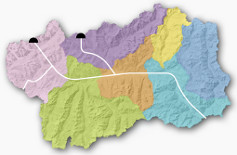The Middle Ages in the Aosta Valley
Complex and picturesque, the medieval period in the Aosta Valley was anything but a dark period
By convention, the Middle Ages began in Europe in 476, when the the last Roman Emperor was removed. It ended around 1,000 years later, with the birth of national monarchies and the Renaissance, but its conclusion has been linked to different dates in each country.
The Medieval period is divided into three phases: Early Medieval (V-IX century), Middle Medieval (X-XI century) and Late Medieval (XII-part of XV century), mainly and respectively characterised by: the meeting of Barbaric and Latin kingdoms, the re-forming of an idea of "public power" (territorial signoria) and the formation of the State.
The medieval period in the Aosta Valley
The Barbaric invasions in the Aosta Valley began with the Burgundians, defeated by Theodoric in the VI century. The region was dominated by the Ostrogoths, to become, some decades later, the province of the Justinian Empire. It was taken by the Merovingian Franchi — the Empire of Charlemagne and then the Borgogne reign — up to the gradual arrival in the area of the powerful, future Counts of Savoy, starting in the XI century. Thus, the Aosta Valley began to be a cultural and political bridge between Italy and France.
Medieval legacy in the Aosta Valley
To get to know the medieval legacy in the Aosta Valley, you should visit the many castles of the region. In such a small area, they show 1,000 years of architecture, which is fairly unique in Italy. The most picturesque castles are at Fénis and at Issogne, as well as at Saint-Pierre, where the Sarriod de la Tour castle boasts beautiful frescoes.
In the Middle Ages, roads where a key factor in political power. In the Aosta Valley, which was crossed by an important section of the Via Francigena, alpine passes were strategic junctions in the Carolingian Empire. Along the medieval roads, florished a thriving hospice network, created and managed by clerics, monks and nuns; the most important hospices in the Aosta Valley are located near the Great-Saint-bernard and the Little-Saint-Bernard passes.
In the city of Aosta, the prior in Sant’Orso and some bishops (including Anselmo of Aosta, namesake of the more famous Sant’Anselmo, philosopher and Archbishop of Canterbury) widely encouraged the creation of high quality figurative art, even bringing artists and workers from other areas. You should visit the collegiate church of Sant’Orso; take a look at the istoriato capitals in the cloister, one of the few cycles in series preserved in Europe; at the wooden choir, the Ottonian frescoes and the priory (Gothic architecture).
Besides, the priory budgets are a precious source of information. They detail the "descriptions" of the noble kitchens and even the recipes used.
Come local carnivals, for instance the carnivals in Quart and Verrès, were able to recreate the costumes in use during the noble age on the basis of iconography research.













